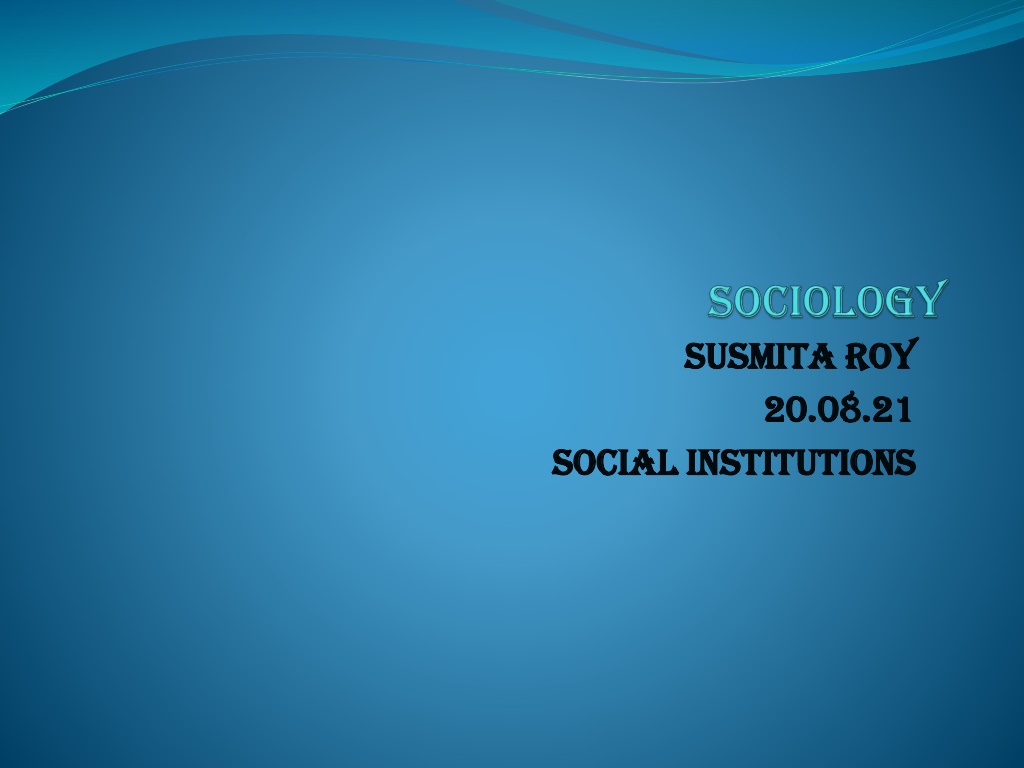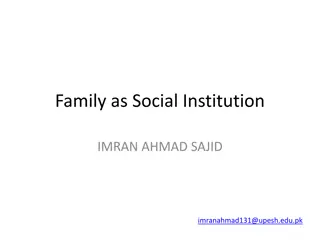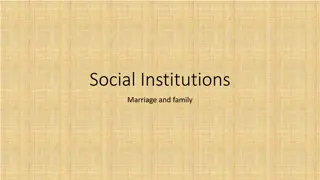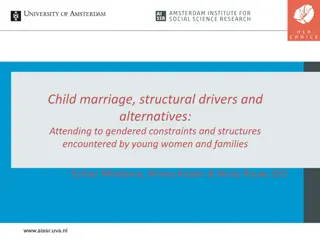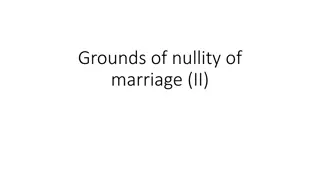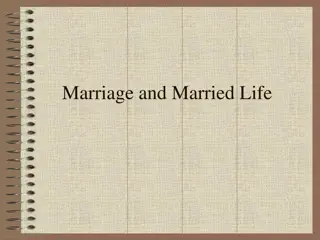Understanding the Institution of Marriage: Types, Rules, and Functions
Marriage is an institution that fulfills the physical, psychological, social, cultural, and economic needs of individuals. It regulates sexual activities and establishes rights and obligations within families. There are different types of marriages such as monogamy, polygamy, and polyandry, each with its own dynamics. Society imposes rules on spouse selection based on religious norms and customs. Additionally, there are perspective and preferential rules guiding marital alliances. Marriage serves various functions, including sexual satisfaction, family formation, and social stability.
Download Presentation

Please find below an Image/Link to download the presentation.
The content on the website is provided AS IS for your information and personal use only. It may not be sold, licensed, or shared on other websites without obtaining consent from the author. Download presentation by click this link. If you encounter any issues during the download, it is possible that the publisher has removed the file from their server.
E N D
Presentation Transcript
SUSMITA ROY SUSMITA ROY 20.08.21 20.08.21 SOCIAL INSTITUTIONS SOCIAL INSTITUTIONS
Meaning and Definition of Marriage Marriage is an institution to satisfy physical, psychological, social, cultural and economic needs of men and women. The primary aim of marriage is the regulation of sexual activities through a stable relationship, which otherwise may cause to social disruptions. Marriage has been defined as an institution for admitting men and women into family life, legitimating offspring and establishing other rights and obligations of husband, wife and children.
Types of Marriage Types of Marriage on the Basis of Number of Mates
Monogamy: this is a form of marriage in which a man or woman remains in marriage with only one man or woman at a time. He/she can remarry another in the circumstances of divorce or death of partner. This is the most common type of marriage present in the world.\ Polygamy: Here, a man or woman is permitted to marry more than one woman or man and live with all partners at a same time. Here, a man is married to more than one woman. This is permitted among Muslims and some of the tribes. Polyandry: Here, a woman is married to more than to one man a) Fraternal Polyandry: Here, woman marries men who are brothers. This practice is common among the Khasi tribes of Uttaranchal . b) Non- Fraternal Polyandry: If the husbands of a woman are not brothers. That form of marriage is called non- fraternal polyandry. This is prevalent among the Nair caste of Kerala.
Rules of Spouse Selection Every society has certain rules to govern the marital alliances among its members. Mostly the members are not allowed to marry whoever they wish. Such rules are listed below, Prohibitive Rules This put a restriction on the selection of mates and is done according to religious norms and customs.
Perspective and Preferential Rules There are some rules which give preference to certain types alliances over others. There are some customs which prescribe or direct implicitly as to whom one should marry or prefer to marry. They are called perspective rules. Some of such rules are as follows.
Functions of Marriage Satisfaction of Sex: Married persons are permitted to have sexual relationship with their respective spouses and not with anyone else. Thus, marriage regularises sexual relations. Procreation & Nurturing of Children; Marriage fulfils the function of producing children and bringing them up according to social norms. Thus, it is an important function of marriage is to ensure the survival of the child. Economic cooperation & Security: marriage provides valuable and reliable help to an individual in economic activities. In a married life, husband and wife look after the economic needs of each other and also the economic needs of their children. Companionship & Emotional Support: Marriage provides a constant companion, a life partner on the form of husband and wife.
Hindu Marriage In Hindu society, marriage is an important Sanskar, a religious duty which every person should perform. The main objectives behind the Hindu marriages are, Performance of religious duty Dharma Giving birth to children Praja Sex satisfaction Rati Hindu Marriage as a Sacrament Hindu marriage is considered to be a sacrament which purifies a person and is performed before the sacred god Agni and is solemnised by a Brahmin. In Hindu texts, there are not any provisions or mentions on divorce. At the time of marriage, mantras are recited, and the couple take oaths.
Changes in Marriage The form of marriage has been shifted from polygamy to monogamy. Special Marriage Act of 1954 has recognised inter- caste and inter- religious marriages. The role of parents and families in choosing the bride and groom is decreasing. Earlier, status was an important criterion for the selection which has changed now. Child Marriage Restraint Act, 1929, abolished child marriage and now the minimum age to get married has been uplifted to 21 as per The Hindu Marriage Acct, 1955. In 1856, Widow Remarriage Act passed. Dowry Prohibition act of 1961 had banned asking for dowry from the groom.
REFERENCES C.N.RAO MAKHAN JHA
